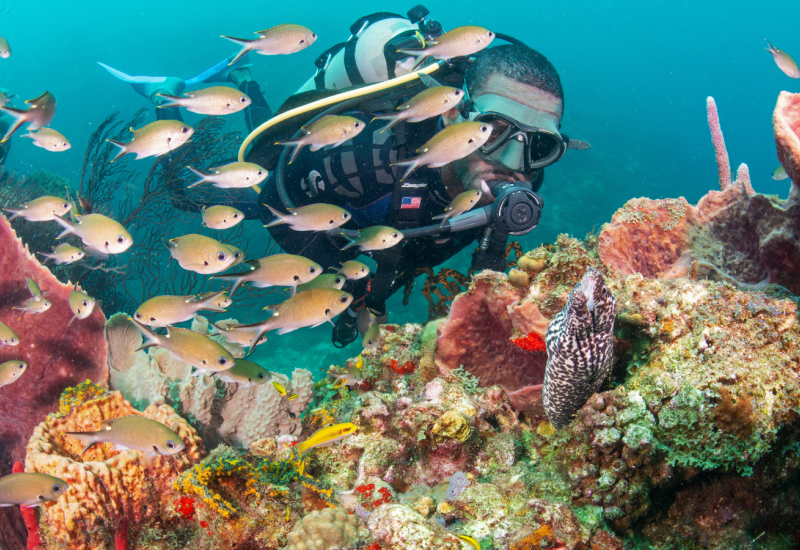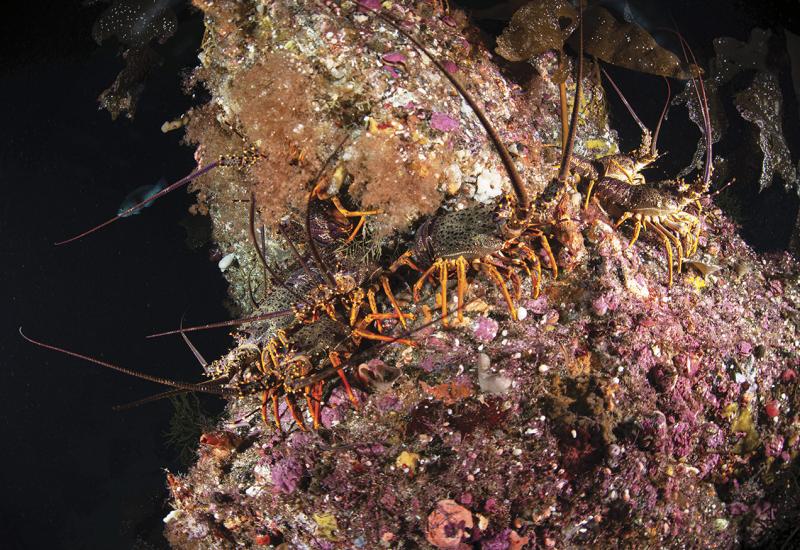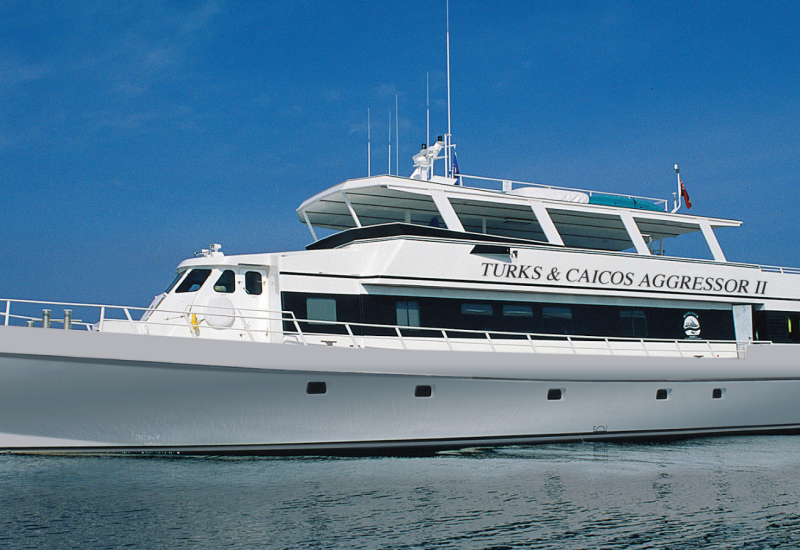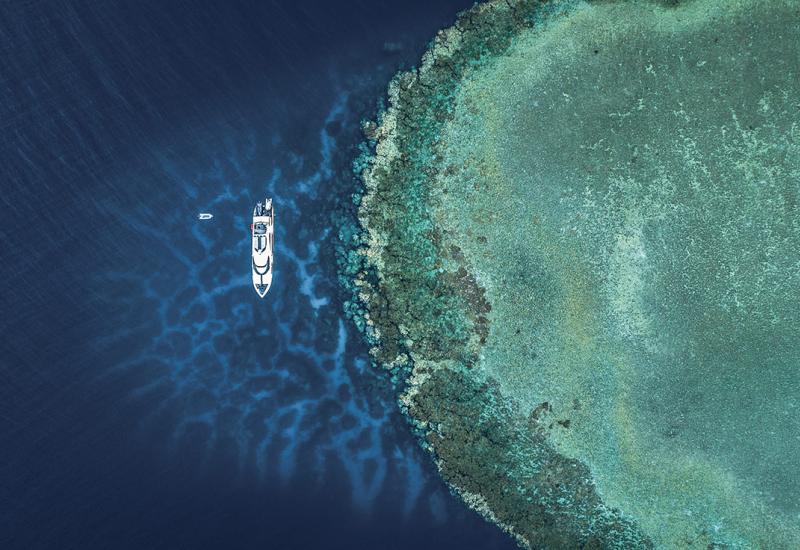Wild Dives in the Coral Triangle
In January we saw a post on Facebook: two spots available on the Howard and Michele Hall cruise on Pindito in Indonesia. Since we were familiar with the excellent work of this award-winning couple — best known for their IMAX productions — we decided to take the plunge. Pindito’s owner, Edi Frommenwiler, would also join our trip from Sorong to Ambon. As a fervent videographer and passionate diver Frommenwiler was one of the first to explore the region of Raja Ampat, long before this area became popular.
Our itinerary would be a full one: a 700-nautical-mile crossing from the islands of Raja Ampat to the Banda Islands — Indonesia’s “Spice Islands” — and wrapping up with an introduction to muck diving in the port of Ambon.
Manta Sandy
Making a back roll in open ocean with the promise of mantas is a great beginning. Manta Sandy and Manta Ridge are two dive spots where mantas congregate to be cleaned by wrasse and even butterflyfish. Both sites are in the Dampier Strait in the center of Raja Ampat, West Papua. This is the epicenter of the Coral Triangle, where currents meet in all directions, bringing nutrient-rich waters, and the best chance to encounter pelagic life and big schools of fish.
Because the currents can be ripping, we are brought to the easiest manta dive: Manta Sandy. As we descend, we understand why — although there is only a mild current, nutrients in the water limit the visibility to a mere 25 feet. Our divemaster guides us to a line of rocks and dead coral where we wait — and wait. After 40 minutes, the first manta arrives, and it is pure magic. It halts in front of the rock formation and hovers easily, not bothered at all by us, and the cleaners start their housekeeping. While we focus on the long-awaited giant, another manta surprises us and joins the action, and then another. We are mesmerized, at least until our bottom time is up.
While Franz, our Indonesian dinghy captain, stows our gear and gets ready to return us to Pindito for a delicious breakfast, we persuade our divemaster Rafael “Rafa” Sauter to take us a little farther into the open ocean, where we watch the wings of mantas breaking the surface. (It was Rafa’s first trip as a cruise director for Pindito, and his kindness and flexibility really added to our trip.) Masks and fins are back on in no time, and we glide into the water. Our group of four disperse to make room so the mantas will not feel threatened in any way. The strategy works and they swim toward us, always keeping a distance, as if teasing us. This encounter is the highlight of our trip. To have this interaction — which lasts for more than 30 minutes, in the middle of paradise, with the sun rising above — is a memory we will treasure.
Lava Flow
Our trip continues farther south to the famous Spice Islands in the Indonesian province of Maluka, where Banda Neira is nestled among 10 small volcanic islands. After spending the night sheltered between Banda Neira and Banda Api islands — enjoying a good night’s rest in our teakwood-paneled cabin — we wake to our “first breakfast”: fresh fruit, oatmeal, a cheese platter and excellent espresso, which is served starting at 6 a.m. (“Second breakfast” — according to each person’s individual order — is a more substantial meal and is always waiting after the morning’s second dive: omelettes, scrambled eggs with toast or delicious Indonesian noodles.)
After our early-morning breakfast, we take a speedboat to Lava Flow, a dive site of coral-covered basaltic boulders created by the 1988 eruption of the still-active Gunung Api volcano.
The cone-shaped volcano is a landmark here — it is covered in lush vegetation that is broken by a wide highway of black lava paved like a road from the top down to the sea, where it entered the water. Given that the eruption was only 25 years ago, it is mind-blowing to see the incredible abundance of huge hard corals and an occasional soft coral. On the entire underwater lava stream, there isn’t a square inch unoccupied by corals. At first glance, it looks like there isn’t much fish life compared with other Banda dive sites. But once we get close to the corals, we can see thousands of juvenile fish. Hundreds of youngsters are playing hide-and-seek, triggered by our presence. Our attention is quickly drawn toward a small school of tiny catfish, its constant 3-D motion beautiful to observe. It is encouraging to see the recovery power of nature when conditions are right.
Twilight Zone
Much too soon our trip brings us to the vicinity of Ambon, our final destination. But before we disembark, we experience some shallow muck diving in search of crazy critters. The Coral Triangle is known for its incredible number of fish species (more than 3,000), corals (600 and counting), nudibranchs and mollusks, so our expectations are high. Any critter would be a treat. Twilight Zone is to be our last dive site, in Ambon harbor. The ride to the dive site gives us an idea of what to expect: The water is heavily polluted; plastic bags, polystyrene-foam food containers and oil spills cover the surface.
We descend to 20 feet to start our dive and are surprised by the amount of life among the garbage: eels everywhere, reef pipehorses, mantis shrimp, cuttlefish, colorful nudibranchs, and anemones with different species of shrimp on them. We don’t know where to look first. As if the small stuff isn’t enough to keep us busy taking pictures and shooting video, out of the depths appears a huge school of catfish, swimming out in the open, since the rocky muck doesn’t provide the coral we usually see them hiding behind. Divemasters Rafa, Marian and Amil point out little gems to the divers who stay close to them. For those who wander or fall behind, it’s not hard to spot the plethora of creatures here. This place is little-critter paradise.
Back on the boat, we settle in for the evening’s entertainment, provided each night on the Hall cruise. Earlier productions by the couple are shown on a flat-screen television in the dining room, covering the making of their IMAX films, as well as reports of their earlier weeks aboard Pindito working on their new movie.
Our last evening on Pindito was filled with joy and laughter: The “house band” — formed by the entire Indonesian crew — gave an excellent song-and-dance performance. A sumptuous feast — including sambal udang (prawns in a red sauce), sawi putih stir fry and ayam peynet (“smashed” fried chicken) — was presented, with all the best the Pindito kitchen had to offer. We knew that night we would miss those excellent dishes, second breakfasts and the afternoon dive snacks — along with the diving and new friends we had made.
In January we saw a post on Facebook: two spots available on the Howard and Michele Hall cruise on Pindito in Indonesia. Since we were familiar with the excellent work of this award-winning couple — best known for their IMAX productions — we decided to take the plunge. Pindito’s owner, Edi Frommenwiler, would also join our trip from Sorong to Ambon. As a fervent videographer and passionate diver Frommenwiler was one of the first to explore the region of Raja Ampat, long before this area became popular.

Rodger Klein, Getty Images
Our itinerary would be a full one: a 700-nautical-mile crossing from the islands of Raja Ampat to the Banda Islands — Indonesia’s “Spice Islands” — and wrapping up with an introduction to muck diving in the port of Ambon.

Kevin Lee

Steve Jones

Tanya Burnett
Manta Sandy
Making a back roll in open ocean with the promise of mantas is a great beginning. Manta Sandy and Manta Ridge are two dive spots where mantas congregate to be cleaned by wrasse and even butterflyfish. Both sites are in the Dampier Strait in the center of Raja Ampat, West Papua. This is the epicenter of the Coral Triangle, where currents meet in all directions, bringing nutrient-rich waters, and the best chance to encounter pelagic life and big schools of fish.

Georgette Douwma, NaturePL.com
Because the currents can be ripping, we are brought to the easiest manta dive: Manta Sandy. As we descend, we understand why — although there is only a mild current, nutrients in the water limit the visibility to a mere 25 feet. Our divemaster guides us to a line of rocks and dead coral where we wait — and wait. After 40 minutes, the first manta arrives, and it is pure magic. It halts in front of the rock formation and hovers easily, not bothered at all by us, and the cleaners start their housekeeping. While we focus on the long-awaited giant, another manta surprises us and joins the action, and then another. We are mesmerized, at least until our bottom time is up.

Ellen Cuylaerts
While Franz, our Indonesian dinghy captain, stows our gear and gets ready to return us to Pindito for a delicious breakfast, we persuade our divemaster Rafael “Rafa” Sauter to take us a little farther into the open ocean, where we watch the wings of mantas breaking the surface. (It was Rafa’s first trip as a cruise director for Pindito, and his kindness and flexibility really added to our trip.) Masks and fins are back on in no time, and we glide into the water. Our group of four disperse to make room so the mantas will not feel threatened in any way. The strategy works and they swim toward us, always keeping a distance, as if teasing us. This encounter is the highlight of our trip. To have this interaction — which lasts for more than 30 minutes, in the middle of paradise, with the sun rising above — is a memory we will treasure.

Steve Jones
Lava Flow
Our trip continues farther south to the famous Spice Islands in the Indonesian province of Maluka, where Banda Neira is nestled among 10 small volcanic islands. After spending the night sheltered between Banda Neira and Banda Api islands — enjoying a good night’s rest in our teakwood-paneled cabin — we wake to our “first breakfast”: fresh fruit, oatmeal, a cheese platter and excellent espresso, which is served starting at 6 a.m. (“Second breakfast” — according to each person’s individual order — is a more substantial meal and is always waiting after the morning’s second dive: omelettes, scrambled eggs with toast or delicious Indonesian noodles.)
After our early-morning breakfast, we take a speedboat to Lava Flow, a dive site of coral-covered basaltic boulders created by the 1988 eruption of the still-active Gunung Api volcano.

Jennifer O'Neil
The cone-shaped volcano is a landmark here — it is covered in lush vegetation that is broken by a wide highway of black lava paved like a road from the top down to the sea, where it entered the water. Given that the eruption was only 25 years ago, it is mind-blowing to see the incredible abundance of huge hard corals and an occasional soft coral. On the entire underwater lava stream, there isn’t a square inch unoccupied by corals. At first glance, it looks like there isn’t much fish life compared with other Banda dive sites. But once we get close to the corals, we can see thousands of juvenile fish. Hundreds of youngsters are playing hide-and-seek, triggered by our presence. Our attention is quickly drawn toward a small school of tiny catfish, its constant 3-D motion beautiful to observe. It is encouraging to see the recovery power of nature when conditions are right.

Ellen Cuylaerts
Twilight Zone
Much too soon our trip brings us to the vicinity of Ambon, our final destination. But before we disembark, we experience some shallow muck diving in search of crazy critters. The Coral Triangle is known for its incredible number of fish species (more than 3,000), corals (600 and counting), nudibranchs and mollusks, so our expectations are high. Any critter would be a treat. Twilight Zone is to be our last dive site, in Ambon harbor. The ride to the dive site gives us an idea of what to expect: The water is heavily polluted; plastic bags, polystyrene-foam food containers and oil spills cover the surface.

Jurgen Freund
We descend to 20 feet to start our dive and are surprised by the amount of life among the garbage: eels everywhere, reef pipehorses, mantis shrimp, cuttlefish, colorful nudibranchs, and anemones with different species of shrimp on them. We don’t know where to look first. As if the small stuff isn’t enough to keep us busy taking pictures and shooting video, out of the depths appears a huge school of catfish, swimming out in the open, since the rocky muck doesn’t provide the coral we usually see them hiding behind. Divemasters Rafa, Marian and Amil point out little gems to the divers who stay close to them. For those who wander or fall behind, it’s not hard to spot the plethora of creatures here. This place is little-critter paradise.

Aleks Bartnicka
Back on the boat, we settle in for the evening’s entertainment, provided each night on the Hall cruise. Earlier productions by the couple are shown on a flat-screen television in the dining room, covering the making of their IMAX films, as well as reports of their earlier weeks aboard Pindito working on their new movie.

Ellen Cuylaerts
Our last evening on Pindito was filled with joy and laughter: The “house band” — formed by the entire Indonesian crew — gave an excellent song-and-dance performance. A sumptuous feast — including sambal udang (prawns in a red sauce), sawi putih stir fry and ayam peynet (“smashed” fried chicken) — was presented, with all the best the Pindito kitchen had to offer. We knew that night we would miss those excellent dishes, second breakfasts and the afternoon dive snacks — along with the diving and new friends we had made.










